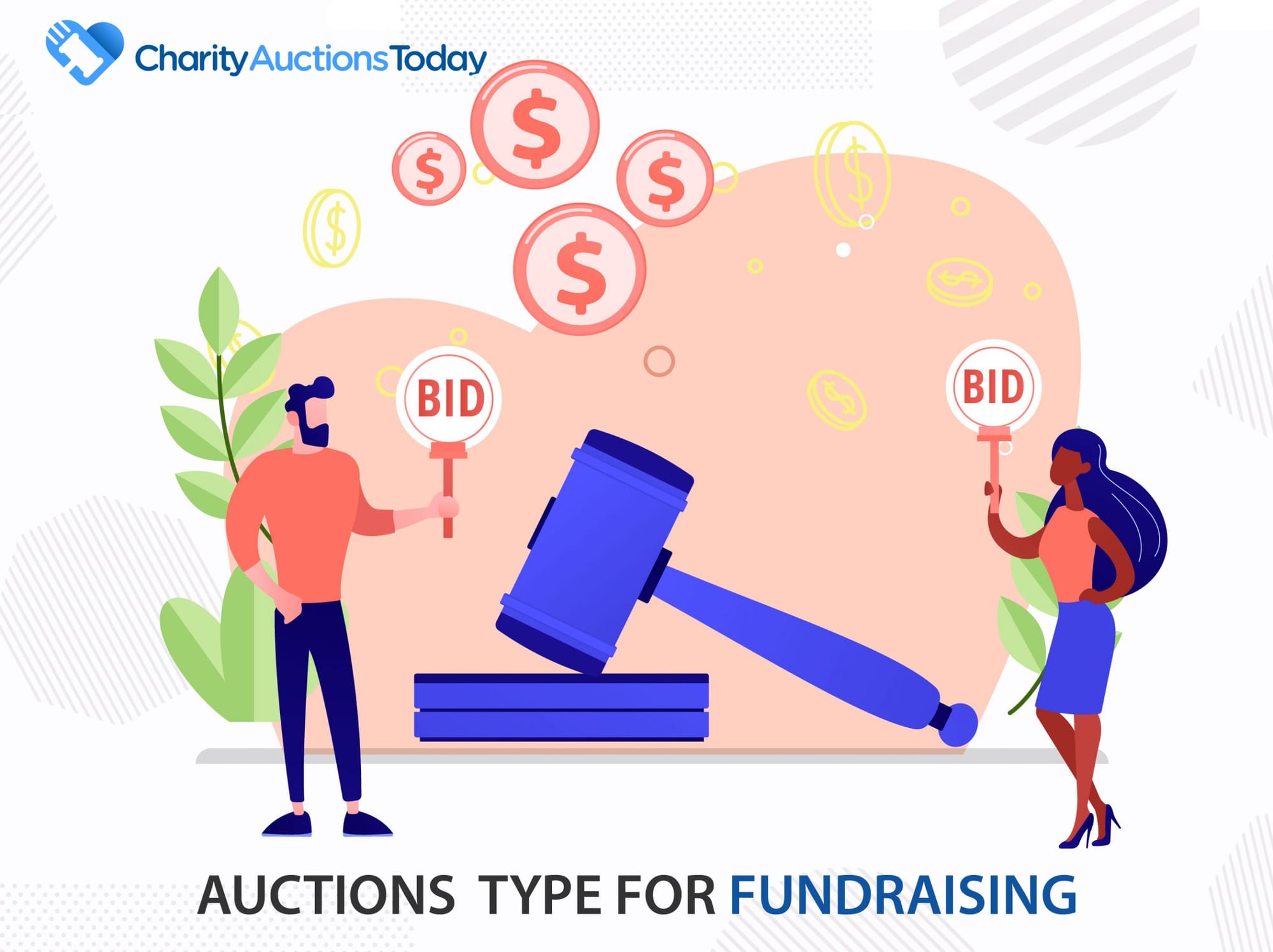Types of Auctions for Fundraising
Who knew there are so many types of auctions? CharityAuctionsToday identifies each type of auction to help you make an easy decision.

Auctions have long been a popular way for nonprofits, businesses, and individuals to raise funds, sell goods, or generate excitement around unique offerings. From silent auctions at charity galas to dynamic live auctions hosted by professional auctioneers, there are many auction formats to consider, each suited to different audiences and objectives.
Don’t Just Learn the Types — Launch One That Works
You’ve explored different auction formats. Now pick the one that fits your cause — and let our platform make setup, bidding, and management effortless.
Start Your Auction NowUnderstanding the various types of auctions can help you choose the right approach for your goals, whether you're hosting an event to benefit a nonprofit or launching an online platform to sell products. This guide explores the most common auction types and their unique advantages.
Types of Auctions Used by Fundraisers
- Live or Open Auction
- Online Auction
- Silent Auctions
- Variations: Sealed Bidding and Hybrid Auctions
Live Auctions
A live auction is a fast-talking auctioneer in front of the bidders, describing items and acknowledging bids.

For charity fundraising, this auction type has evolved. It encompasses the basics of presenting the items for sale and allowing bidders to bid on them, but the way the items are displayed, the description of the items, and the bid process can change based on the desires of the organization.
For a typical live fundraising auction, the bidders have a set time to look at the merchandise. They may also use a printed or online catalog with images and descriptions like our online auction software. The physical items are placed on display for bidders to evaluate.
At the beginning of the bid process, the auctioneer presents items (or the description of services). The highest bidder wins when no one else chooses to outbid them. These types of auctions are the fairest, as they allow all parties to see the auction items and the bidding process to ensure no cheating.
Some live auctions might be limited to whomever is in the room, but others will allow bidders to have proxies: a representative to bid for them, sometimes by being on the phone with them as the auction happens. You might see this more at for-profit auctions like at an art auction. Each auction house has its own rules and guidelines.
Online Auctions
An online auction is similar to a live or open auction. The main difference is that the items and descriptions, along with the bidding and payment processes, are listed online. In this type of auction, multiple items or services are bid upon at the same time.
Even in a live environment, mobile and wireless devices can be used to research items and bid on them. Online auctions have rapidly become a staple of fundraising auctions as they offer efficiency and flexibility that a simple live auction cannot.
If the online auction is a pure internet auction, with no set physical location, the items are listed in an e-commerce style environment. The images and descriptions are posted for bidders to read with a bid button to enter their bid amount. The auctions are set over a specific time – from a start date to the finish date and sometimes include a starting (minimum bid) with set increments for additional bidding.
Online auctions also allow for email or text notifications when a bidder is outbid. This increases the excitement for the auction and often results in higher bidding. The items no longer take precedence, and the bidders focus on winning the item no matter the cost.
Online auctions offer several advantages. The main advantage is the number of bidders. With the proper online auction software, a bidder with a mobile, tablet, or internet device can place a bid anywhere in the world. This allows potential bidders interested in supporting the charity (or who just want the item) to participate.
Online auctions also make it easier to see exactly who bid what and when. Sometimes live auctions are chaotic, with people shouting bids over each other. Even if your MC is hyping up each individual item live, if you instruct your bidders that only online bids will be considered, it can take a lot of the guess work out of this type of auction.
It also helps when it comes time to take payments from winning bidders. And you can maintain the sense of excitement at your live auction by showing the item on a big screen and watching the bids roll in.
Sealed Bid Auction
This type of auction is either live or online. All bids are kept confidential. After a set time when all the bids are submitted, only the winning bid is disclosed. In a true sealed bid auction, the bids are sealed in an envelope and only opened at the close of the auction to find the winner.
This same process can be achieved online, though it loses some of its mystique. While these bids are used for charities and fundraising, they are most common in a real estate environment where multiple factors influence the sale. This allows the seller to analyze not only the top bid but the terms of the sale as well. A bidder who offers a slightly lower purchase price but can pay cash right now may be more desirable than the bidder who offers a higher price but must secure financing.
Hybrid Auction
These auctions are any combination of the previously described auctions. Some examples of hybrid auctions include:
Simulcast Auctions – This type of auction uses multiple live event locations with closed circuit or internet communications allowing bidders in multiple locations to bid on items.
Simulcast Sealed Bid Auctions – This is similar to the Simulcast Auction, but includes the elements of a sealed bid, where only the winning bid is disclosed at the end of the auction.
Online/Live Auction – Many fundraisers have set up online auctions allowing pre-bidding. This allows potential bidders to view and bid on items weeks before the live event. This will then determine the starting bids for the live event.
Chance, or "Chinese" Auctions
You might have heard of "Chinese" auctions. This is an outdated term for chance auctions, which are also sometimes called penny socials or tricky tray auctions. Some people consider them a type of raffle rather than an auction.
All these auctions involve is the ability to buy tickets and place them (in person or virtually) in the bucket, jar, or box of the auction items you want, so that you'll have more chances of winning it. Read more about this type of auction with our piece, Understanding the Basics of Chinese Auctions.
Types of Auction Bidding
You might be setting up your auction and confused about the bid settings available to you. Here we break down some different bid methods and options that can help you customize your auction experience and suit your needs.
Pre-bidding – Allows potential bidders to bid on items before the actual auction is live. For live auctions, this allows multiple bidders to drive up starting prices for the actual auction.
Traditional Bidding – The standard type of bidding process where the auctioneer (or online software) opens bidding, and the audience continues to bid on the item until the end of the desired time slot.
High Bidder’s Choice – Similar items or properties are grouped on display for all bidders. The bidders then bid for the right to select the item or property of their choice from the group. The winning bidder’s choice is then removed, and a new round of bidding starts on the remaining items.
This bidding style is common for the auction sale of new construction condominiums or townhomes but is also used in charity events. It can create a massive level of competition as people with different desires and values are competing on one item a lot without knowing the intentions of other bidders.
Multi-Par Bidding – Multi-Par Bidding is used on the sale of large, undeveloped land where multiple plots of land are offered. This method allows the bidder to place bids for various configurations of lots based on the bidder’s desire to assemble the parcels.
Absolute or Without Reserve – There is no minimum bid, and the seller is committed to sell the item to the highest bidder, regardless of price.
Minimum Bid or Disclosed Reserve – Bid requires a minimum dollar amount to be disclosed, which commits the seller to sell the item or service to the highest bidder at any price above this minimum bid.
With Reserve – Used frequently in real estate, the seller has the right to accept or reject the highest bid. This means the seller does not have to sell the item or service to the top bidder if they did not meet their minimum, or reserve price.
Learn more about how to conduct silent auctions.
What Type of Auction is Right for You?
Charities and Fundraisers have a wide variety and combination of auction types to not only maximize revenue but also increase the excitement and fun of the event. There is no right way to operate your auction, but there are strengths and weaknesses in all of them.
Live auctions have a high sense of excitement, but they tend to increase costs due to renting and planning the venue needed for the event. In addition to the increased cost, the length of the event may limit the number of items you can auction. It may also restrict potential bidders and donors from attending.
Sealed bid auctions work in a real estate environment with long inspection cycles, but they can lack the competitive energy bidders will feel while bidding against other bidders. In a short inspection and auction time, the seller may not achieve the highest bid possible for the items being auctioned.
Online auctions have many strengths, including allowing bidders from all over the world to bid on items. Coupled with live or simulcast events, this type of auction invites a broader base of potential bidders. Online auctions are completely transparent, showing the last bidder, the current bid, and the time between bids. With the right online auction software, like that from CharityAuctionsToday, you will find yourself with the most powerful tools to increase revenue and further your cause.
Now that you've learned about different types of auctions, you might be ready to choose your online charity auction platform. We've made that easy for you by exploring today's top 12 online auction platforms.

Final Thoughts
Choosing the right auction format can make all the difference in achieving your fundraising or sales goals. Whether it’s the traditional energy of a live auction, the convenience of an online auction, or the silent excitement of mobile bidding, each type has its strengths and considerations. By aligning your auction type with your audience and objectives, you can create a successful and engaging event that maximizes results. With careful planning and the right tools, your auction can become an impactful tool for driving success and fostering meaningful connections.
Frequently Asked Questions
What are the main types of auctions for nonprofits?
The most common formats are live auctions, silent auctions, online auctions, and hybrid auctions. Variations include Big Board, sealed-bid, Dutch, “Chinese auction” (basket raffle/tricky tray), and the non-bidding Fund-a-Need (paddle raise).
What is a live auction and when does it work best?
A live auction features an auctioneer calling ascending bids in real time. It’s ideal for a short set of premium items, a high-energy crowd, and when you want to spotlight mission moments on stage.
What is a silent auction and why is it popular at galas?
Bidders place written or mobile bids without an auctioneer. It lets many guests participate at once, works well for mid-range items, and can run before dinner or alongside other program elements.
How does an online auction differ from in-person formats?
An online auction runs on a website for several days so supporters can browse and bid from anywhere. It expands reach, adds convenience, and allows automated outbid alerts and extended bidding.
What is a hybrid auction and when should we use it?
Hybrid combines on-site experiences with remote bidding. Use it when you have off-site supporters or limited venue capacity but still want event-night excitement and broad participation.
What is a Big Board auction format?
A Big Board displays featured items and their current top bids on a large board or screen. It creates visibility and urgency for a curated set of mid- to high-value items during the event.
Is a Fund-a-Need considered an auction type?
Fund-a-Need (paddle raise) isn’t a bid-to-win auction; it’s a direct ask for donations at tiered levels. It often raises the most money per minute and pairs well with live or silent formats.
What is a sealed-bid auction and when is it useful?
Bidders submit one confidential bid per item by a deadline; the highest bid wins. It suits limited-time displays, high-end items with privacy needs, or settings where open competition may deter participants.
What is a Vickrey (second-price) sealed-bid auction?
In a Vickrey auction, the highest bidder wins but pays the second-highest bid price. It encourages honest bidding but is rarely used at charity events due to complexity and guest education needs.
What is a Dutch auction and should nonprofits use it?
A Dutch auction starts at a high price and drops until someone accepts. It’s uncommon for charity items but can work for selling multiple identical items (e.g., seats, merchandise) quickly.
What is a “Chinese auction” (also called tricky tray or penny social)?
Guests buy tickets and drop them into containers for items they want; a winning ticket is drawn for each item. It’s easy to run and family-friendly, functioning more like a basket raffle than an auction.
What is a Buy-It-Now option and how does it fit into auctions?
Buy-It-Now lets a guest purchase an item immediately at a set price, ending bidding on that item. It captures decisive buyers and can lift revenue when priced thoughtfully.
How do we choose the right auction type for our event?
Match format to your audience, venue, item mix, and goals. Use live for premium items and energy, silent/online for breadth, hybrid for reach, and always consider adding a Fund-a-Need for direct impact.
Can we combine formats—and how do we keep endings fair?
Yes. Many events pair a short live auction + Fund-a-Need with a silent or online catalog. Use staggered closings or extended bidding to prevent last-second sniping and give all bidders a fair chance.
💡 Try this in ChatGPT
- Summarize the article "Types of Auctions for Fundraising" from https://ghost.charityauctionstoday.com/p/types-of-auctions/ in 3 bullet points for a board update.
- Turn the article "Types of Auctions for Fundraising" (https://ghost.charityauctionstoday.com/p/types-of-auctions/) into a 60-second talking script with one example and one CTA.
- Extract 5 SEO keywords and 3 internal link ideas from "Types of Auctions for Fundraising": https://ghost.charityauctionstoday.com/p/types-of-auctions/.
- Create 3 tweet ideas and a LinkedIn post that expand on this General Auction Info topic using the article at https://ghost.charityauctionstoday.com/p/types-of-auctions/.
Tip: Paste the whole prompt (with the URL) so the AI can fetch context.
Tom Kelly
Tom Kelly, TEDx speaker and CEO of CharityAuctions.com, helps nonprofits raise millions through auctions and AI. He hosts The Million Dollar Nonprofit podcast and inspires leaders to live their legacy, not just leave it.
Table of contents
Create Your Auction
Raise 40% more with smart bidding tools





